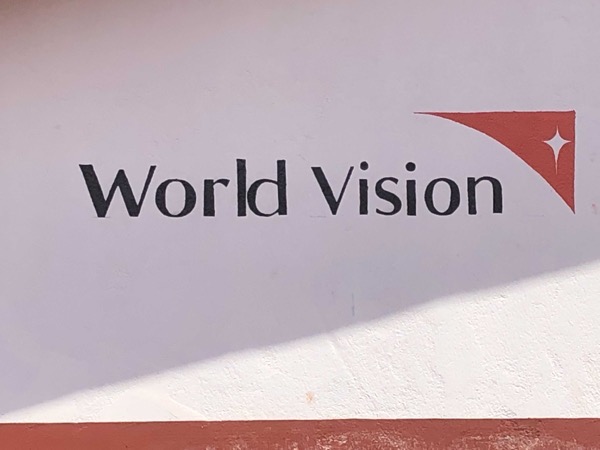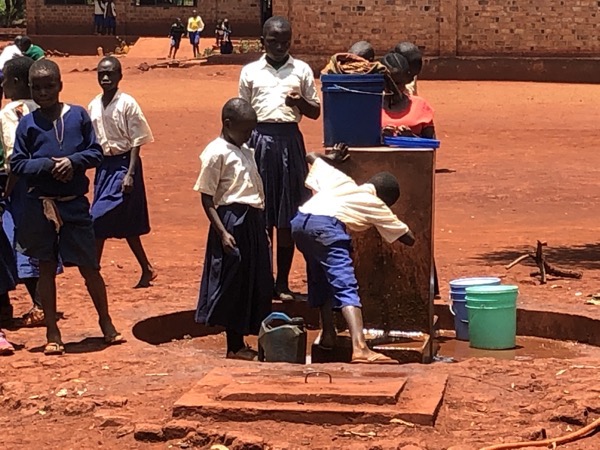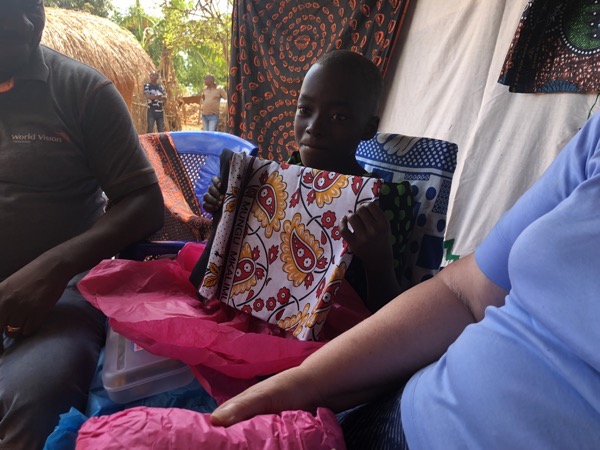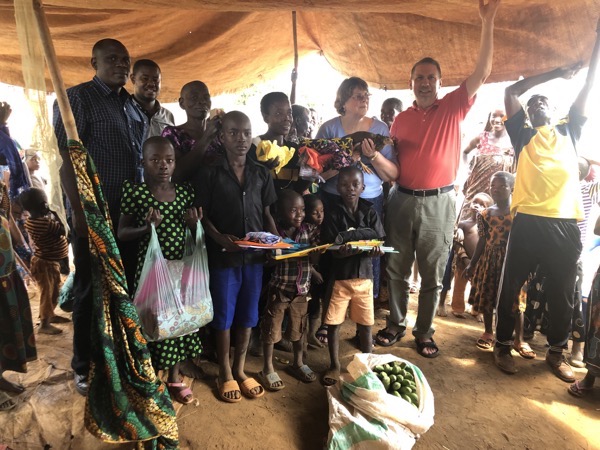One of our plans for this week was to visit with the child we are supporting though World Vision. She is 11 years old and her name is Daines. She lives with her mother, father and four brothers in a remote village here in the Kasulu region of Tanzania.
World Vision in America had arranged for us to meet with the local World Vision representative here at the compound on Tuesday and then go out to the see the projects World Vision is engaged in where our child lives on Wednesday. At least that’s what our emails said.
While Bill was working at the the Bible College on Monday, I took Joe on a shopping excursion of downtown Kasulu. My goal was to buy two kongas – one each for our World Vision Child, Daines and one for her mother. I also wanted to get a new mosquito new for our bed (one of the zippers on our previous one was broken. Joe is looking for some bracelets to bring home to his daughters.
My friend, Olivia, has a konga shop and I was able to find two appropriate kongas there. Then she closed up her shop to help me find the new mosquito net. Joe was able to find one bracelet in a shop next door and then Olivia helped be find some Africaf as we go through it very quickly. I forgot all about getting poor Bill’s mango juice!
After lunch I went back to the compound and started wrapping gifts for Daines and her family. It was a good thing that I had not waited to do my shopping until Tuesday as later that afternoon, the World Vision Representative (Simon) arrived to give us our pre-visit briefing. Our visit would actually be on Tuesday! Everyone was expecting us the next day, so Tuesday, we would go!

We are the first sponsors to ever visit this project. And we are fortunate to have visited Western Tanzania over many years and have gotten to know the culture. I would like to think that we will not be the last sponsors to ever visit the project. It is in a remote area that takes a lot of traveling to get to and it is good to already be familiar with the “double hugs” and somewhat elaborate handshakes that can come with greetings and farewells.
Simon picked us up at the compound at 8:00 a.m. We followed the road toward Kibonda until we reached the Buhoma’s project offices. After meeting the staff there and going over some preliminaries (including signing papers that spelled out rules for our privacy and the children’s safety), we were fed a lovely traditional breakfast. Then it was time to visit the projects!
To reach some on the projects, we drove through one of two remaining refugee camps in the area. It was huge and went on for miles. We think of refugee projects as being filled with tents, but this camp has been there for many years and the tents have been replaced by small houses. We passed several schools and signs indicating food distribution points and dispensaries. I think the thing that struck me most was the regimentation of the buildings, the signs identifying zones and the signs identifying villages which only bore letter-number designations instead of names. I understand that 100,000 people still live in this camp. Tanzania wants so encourage them to return to their countries of origin so their opportunities for trade, etc. in the camp are limited.
The first project was a school where WV had built two additional classrooms and additional sanitary facilities for boys and girls. The girls sanitary facilities included a place where menstruation materials can be burned. Even with the new classrooms, classes are extreemly crowded with an average of 100 students per class! To help combat the poor literacy rates, WV has set up Saturday “reading camps”.

Next we visited a dispensary that World Vision built in cooperation with the government and national health. It is staffed by a physican’s assistant and provides many preventative services such as immunizations and provides and initial location for folks to go if they are sick. Before it was built folks had to walk for many miles to get any health care at all so they often did not seek it out but relied on traditional methods of healing until they became very sick.

We visited a water project and then headed for Daines’s village where we were greeted by her family and neighbors. Daines’s mother and grandmother both met me with the “double hug” (hug on one side and then the other) Daines appeared shy and appeared a little overwhelmed by the whole thing.
They had set up a tarp to shade us from the sun and we led to seats of honor, with Daines sitting next to me, her Dad sitting next to Bill, her mother and brothers on the other side of Simon, our WV rep. We were introduced and said a little bit about ourselves. We did a little bit of question and answers. There was a lot of quiet staring at us and Daines and I talked a little bit (through the translator of course) about her favorite subjects at school.


Eventually lunch was brought out and things got livelier: We were served first and it was the traditional feast including fried chicken, cooked bananas, beans, etc. They also provided large bottles of water and two bottles of soda each for the visitors. After we and the family were served all the neighbors were served. Plates plied high with rice and vegetables were brought out of the house and shared around. Most plates were shared by several people with some plates given to groups of kids who were sitting on the ground to share. Everyone dug in with their hands. Everyone enjoyed the food.
I went to the car to get the gifts that I had brought: notebooks, pens, pencils, coloring books and crayons, shirts for the boys, a dress for Daines, and blouse for her Mother and kongas for both. And I included some of our family pictures. We all had fun as they unwrapped their gifts.

What I did NOT expect was that they had gifts for us. A chicken, green bananas, cassava, ground nuts…more food than we can eat while we are here and a real sacrifice of family resources. But when you are given gifts of the heart such as these, you don’t turn them down. You accept them with joy and figure out what to do with them later.

The neighbors had asked several times that we stay with them longer (overnight), but we explained that we had friends waiting for us back in Kasulu. We headed back, first to the Buhoma project office to drop off some folks and then to Kasulu. The roads were in pretty good shape, but riding for probably three hours total on even good dirt roads can be tiring. Bill and I took “Kasulu” showers, had dinner and were in bed, lights out, before 8:00 p.m.
A good visit but one the I won’t be repeating yearly: I don’t want to be a drain on the community resources.
Leave a Reply
You must be logged in to post a comment.